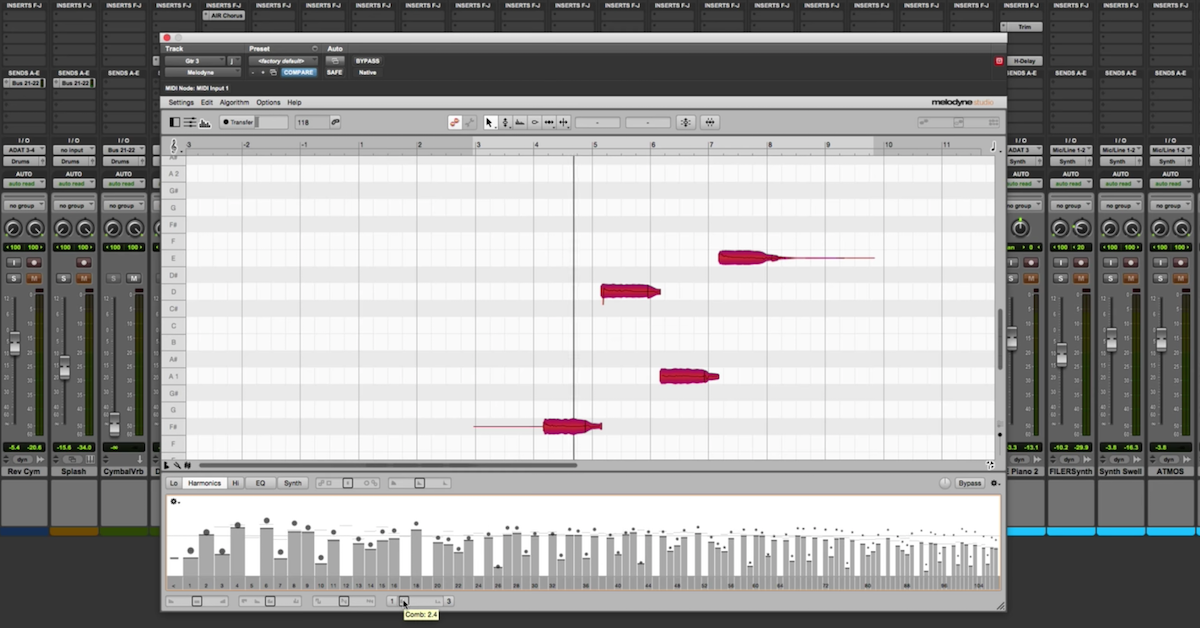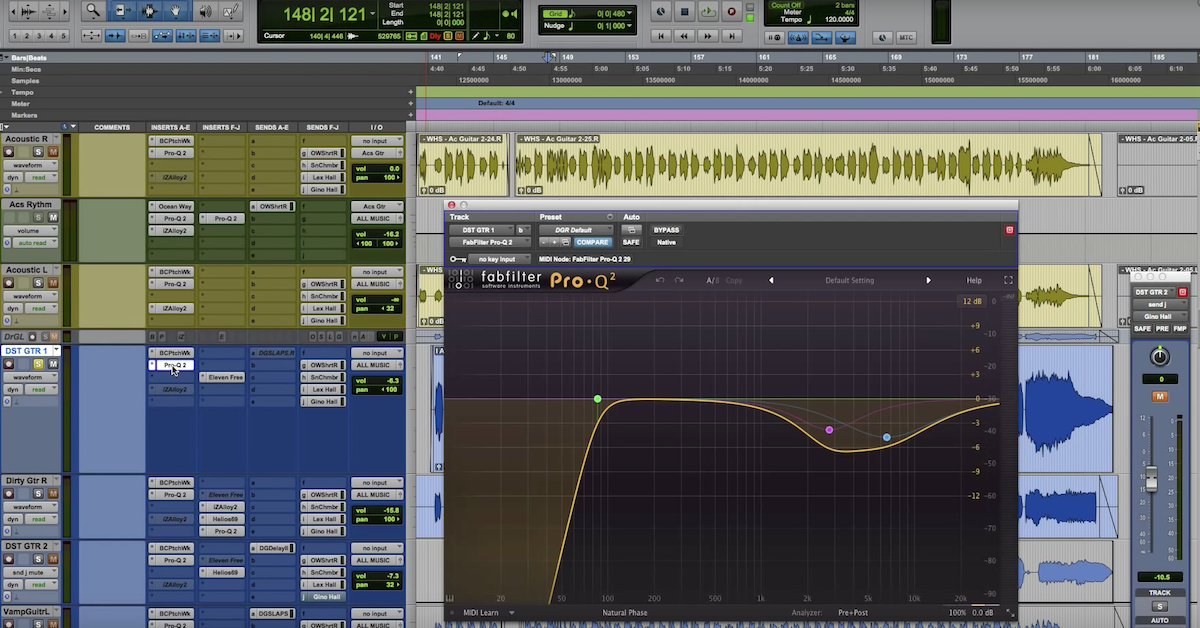How to Simulate a Double Tracked Guitar
Here’s a song that I’m working on.
[mix]
So I got sent this song to mix, and you can hear, it’s pretty bare bones. There’s the drums, there’s the bass that comes in, and there’s one main electric rhythm guitar part, and you know, every once in awhile, there’s a little lead part and stuff that comes in, but as far as the instrumentation, that’s basically it. There’s vocals that come in later on too, but I’m just focusing on the instruments right now.
So if I were the one recording this song, or producing this song, my personal preference is to have the rhythm guitar part where I have the guitarist double track the part where they would record one take playing the rhythm guitar part, and then we’d start all over again, and they would record basically playing the same exact thing a second time, and then have both of those things. I’d pan them out to the left and to the right. It gives you a nice wide guitar part, leaves space for the bass in the center of the mix, and it sounds good. It sounds full.
That’s typically what I like in my electric guitar.
However, sometimes, as the mixing engineer, you’re going to be in a position where you don’t really have a choice. You’re just stuck with whatever it is for good, for bad, and you can’t really go back to the client and say, “Hey, will you record this guitar part again? I think that it would sound a lot better.”
And if you have the creative freedom as the mixing engineer, and you want to have that double guitar part, well, rather than playing the part yourself or having to deal with it, here’s a trick that I came up with for taking a mono part and getting what sounds like two out of it.
If you’ve ever heard this in a song, or mixed it, or recorded it yourself, you know exactly what it sounds like. The thing about it is, the left side and the right side, they have to be slightly different for it to sound like double tracked guitars, so when a human plays, the left side and the right side, the two parts aren’t exactly the same. They’re off slightly in time with each other.
Not by constant time difference, but maybe some notes are a little earlier, some notes are a little later. Maybe some of the notes are a little bit higher in pitch or lower in pitch. You know, that’s what gives it its nice, wide sound. So I’m going to introduce those kind of variations myself as part of just mixing, and so here, I’ve got the main electric guitar part. It sounds like this.
[mix, then guitar]
So, decent sounding. Slightly overdriven electric guitar part.
Then what I did is I duplicated it twice. So I’ve got one for the left, and one for the right. Exact same signal. Now you can hear them together.
[mix]
So right now, I’ve got the same thing on both sides. It doesn’t sound wide, because you know, panning things out, having a duplicate signal panned out, that’s basically what panning stuff to the center does, is it — plays something out of the left speaker and it plays something out of the right speaker at the same amplitude.
So not really getting the effect just by duplicating it and panning it out. So really what comes in now is how do we create these slight variations in timing and slight variations in pitch?
A couple of ways to go about doing this. So I’m going to find my right guitar part, and I’m going to mix the variations on the right side, and leave the left side as it is. So let me grab this region here, this audio file, you can see, it’s identical to the one right up above it for the left side, and I’m going to turn on elastic audio.
So here on the editor window, I’m going to go in, and I’m going to turn on polyphonic elastic audio. So this is where you can stretch and move the timing around of the different detected notes on this signal. What I’m going to do is switch over to the warp view for this. I’ve got everything highlighted now, and now, if I wanted to just grab a certain section like this, and the trick to it, to make your process go fast and smooth and do so in a timely way, is you can do it manually if you want, or what I’m going to do is come up here to the event menu and find one that says, “Event Operations,” and go to “Quantize.”
So quantize is changing the timing. Now, if you — the typical way of doing quantization is to line everything up perfectly to the grid. I’m not trying to line everything up, I’m trying to actually scatter things around and throw off the timing of things, so in fact, what I’m going to do is click on this randomize, and the only way I’m going to change the timing is through randomization. Turn everything else off. Then I can play around with this scale about how much I want to randomize it.
What’s going to happen is some of the notes now are going to be a bit before they were before processing it, and some of the notes are going to be a little bit afterwards.
So I’ll hit this button, we’ve thrown things off a little bit. Let’s listen back to these two parts together.
[guitar]
So hopefully you’re able to hear, some of the times, when the strum happens, it happens first on the right side, so it seems like that’s kind of happening first, and other times, it happens on the left side. You know, and you can do this by a small amount, by a large amount, and it’s going to change how wide it ends up sounding.
[guitar]
Right? If I bypass it, or undo it…
[electric guitars]
It immediately just jumps out extra wide. So that’s my first step. I’m going to show you one more step that I like to do here. So one of two steps. The next thing I’ll do is actually play this recording into Melodyne. Melodyne has some cool things about randomization as well that’s useful for this kind of stuff.
So I’m going to transfer part of the recording in, just for the right side.
[guitar, transferring into Melodyne]
That’s plenty. We’re going to wait for it to go through its detection. It’s trying right now to detect all these different notes based on the harmonics and everything. I actually don’t need all of this stuff. It’s more than really necessary for me, so what I’m going to do is grab all of these notes, and I’m going to switch the algorithm over to melodic. So now, it’s going to go through redetection.
So instead of having a bunch of different notes, it just has the main chord that’s being played. Then what I’ll do is go into Melodyne, under this edit menu, and find this randomization. So add random deviations.
You can do it in timing, or you can also do it in pitch. I’ve already done the timing one by using elastic audio. Then I’m going to come in here and maybe just start out with subtle changes in pitch.
[guitar, adjusting pitch]
So now it’s a lot like if a person played a recording, then they started over again, maybe their guitar isn’t exactly in the same tune that it was before, that kind of thing, what I’ll do is show you the other options.
It can get pretty extreme if you go up to moderate or drastic, where it starts to sound a little weird.
[guitars, more drastic pitch shift]
Yeah, that’s a little bit too funky for me.
So what I’m going to do is just turn on subtle pitch changes, and that’s really it. I think those two steps of changing the timing and changing the pitch by a little bit, it’s really going to widen things out. Remember, I just started with the single mono thing, and you know, when you listen back to it in the context of the mix, it sounds like they spent the time during the tracking phase to lay two parts down and it makes a lot more space in the center of the mix for the bass, and also when the lead guitar comes in, rather than having it overlap.
So I’ll play it back and let you listen to that.
[mix]
So that’s it guys. Let me know if you have other techniques or tricks that you like to do for performing this same kind of task, and I will catch you next time. Take care!





